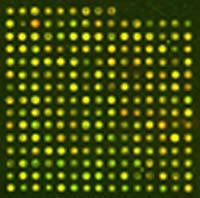Brain cancers: DNA chips improve diagnosis of gliomas

When CGH chips light up… Each point represents a DNA probe of about 150 000 base pairs on which the sample DNA has hybridized. The green spots correspond to regions where a deletion has occurred, and the red spots to regions that have been amplified. © Ahmed Idbaih/Institut Curie
Institut Curie and Inserm research scientists and physicians have just shown that precise knowledge of alterations in chromosome 1 can be used to improve the treatment of gliomas, the most frequent brain tumors in adults. Diagnosis and treatment of these tumors are difficult because of their heterogeneity and variable malignancy. Using DNA chips, the authors of this report were able to distinguish the tumors with the best prognosis, whose chromosome 1 has undergone a specific deletion. Screening for these deletions should be incorporated into standard diagnostic tests by the end of 2005.
These results are published in the September 2005 issue of Annals of Neurology.
Gliomas are the most frequent brain tumors in adults, and account for over 50% of primary tumors. They are classified into three groups: astrocytomas – 70% of all these tumors – derive from astrocytes, cells close to the neurones; oligodendrogliomas derive from cells that produce the sheaths of nerve fibers; and oligoastrocytomas which are mixed tumors combining the characteristics of the first two types.
Gliomas are graded I to IV according to their malignancy. Grade 1 tumors are clinically benign and can be treated surgically. Grade II, III and IV tumors are increasingly malignant and require additional treatments (chemotherapy and/or radiotherapy).
Classification and grading of gliomas are essentially based on subtle microscopic characteristics and are therefore problematical. There is no specific marker or genetic signature, and the present classification seems inadequate in predicting the outcome of each type of glioma.
Chromosome 1 and the prognosis of gliomas
By studying the specific genetic alterations of a subgroup of more chemosensitive gliomas, their classification can be refined: the loss of the short arm(1) of chromosome 1 has thus been associated with a better prognosis and improved response to chemotherapy.
Jean-Yves Delattre(2) and his team at the Pitié-Salpêtrière Hospital and Olivier Delattre(3) and his team at the Institut Curie have identified several types of deletions of chromosome 1, only one of which is associated with gliomas with a good prognosis. These findings were recorded using array CGH analysis (see “Further information”), a technique that can establish high-resolution maps revealing genome anomalies (amplifications, deletions). Only the complete loss of the short arm of chromosome 1 combined with complete loss of the long arm of chromosome 19 signifies a good prognosis. Partial loss of the short arm of chromosome 1, on the other hand, characterizes more aggressive tumors. This retrospective study was done with samples from the tumor library of the Pitié-Salpêtrière Hospital using a technology developed at the Institut Curie.
In terms of fundamental research, these findings suggest that the genes involved in these two deletions, and hence associated with gliomas of good and poor prognosis, are different.
In clinical terms, the array CGH technique should improve the diagnosis of gliomas and hence their treatment. Screening for these chromosome 1 deletions should be incorporated into standard diagnostic tests by the end of 2005.
Genomics and notably DNA chips generate new information on the alterations underlying cancers. Using these tools, physicians can revamp and refine tumor classification to enable more individualized treatments.
Media Contact
More Information:
http://www.curie.frAll latest news from the category: Life Sciences and Chemistry
Articles and reports from the Life Sciences and chemistry area deal with applied and basic research into modern biology, chemistry and human medicine.
Valuable information can be found on a range of life sciences fields including bacteriology, biochemistry, bionics, bioinformatics, biophysics, biotechnology, genetics, geobotany, human biology, marine biology, microbiology, molecular biology, cellular biology, zoology, bioinorganic chemistry, microchemistry and environmental chemistry.
Newest articles

First-of-its-kind study uses remote sensing to monitor plastic debris in rivers and lakes
Remote sensing creates a cost-effective solution to monitoring plastic pollution. A first-of-its-kind study from researchers at the University of Minnesota Twin Cities shows how remote sensing can help monitor and…

Laser-based artificial neuron mimics nerve cell functions at lightning speed
With a processing speed a billion times faster than nature, chip-based laser neuron could help advance AI tasks such as pattern recognition and sequence prediction. Researchers have developed a laser-based…

Optimising the processing of plastic waste
Just one look in the yellow bin reveals a colourful jumble of different types of plastic. However, the purer and more uniform plastic waste is, the easier it is to…



